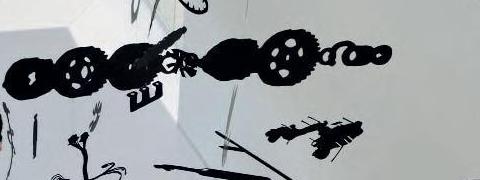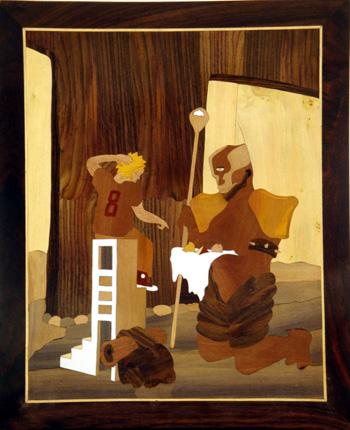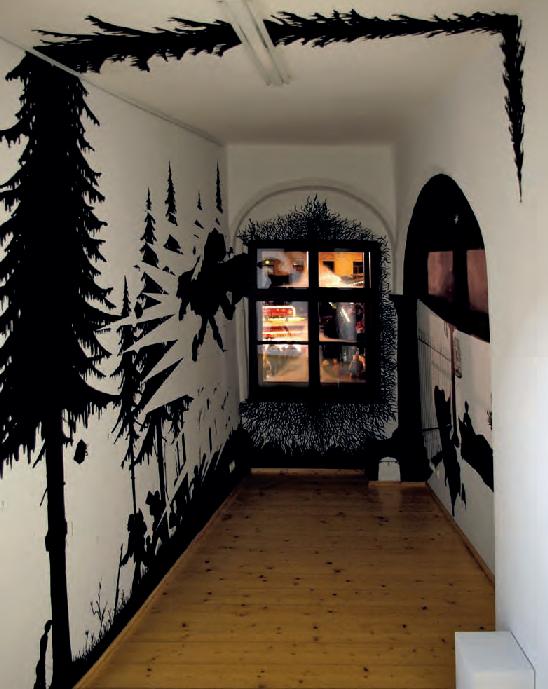East London. What use to be a small emerging area of social art is now bombarded with hipster lemmings or ‘contemporary creatives’ (as they prefer to be addressed).
This phenomena, and strict uniform of up-cycled teddy boy and pre-war housewife chic, has made me frosty to the produce of so-called young artists, designers, innovators…blarddey blarh.
Hope has been retrieved in the form of IMT Gallery, hidden within Cambridge Heath Road and Vyner Street (considered the Fine Art area of Shoreditch). The Curators/Owners are often respected artists themselves, exercising their underground networks to source skilled talent.
German-based artist Henrik Schrat’s solo show Report on Probability B is a nod towards true craftsmanship as he presents a series of wood inlays. Schrat’s inlays are pictures made entirely from different coloured woods, all hand cut and beautifully lacquered. The standout is that the collection is made to be viewed as a story following an original narrative by the artist, entitled Space Odysee.
The Space Odysee follows a young traveller on his voyage to ‘discover new worlds and new civilizations’ (you know the rest). Along the way he befriends a one-eyed alien, but the hope of connecting with new species sadly ends as the earthling is valiantly carried away in the alien’s arms.
The title Report on Probability B is a gesture to true sci-fi theory as Schrat’s alternative view of Brian Aldiss’ (1968) tale ‘Report on Probability A’.
For anyone with no previous interest in or knowledge of the ‘trekky’ world, don’t fret. The works are the main factor of any successful fine artist, they should be visually exciting, and are. Just try to abstain from stroking the glossy grains of the wood!
[box] Result? The temptation to lick the shiny exterior from underneath the cloths. [/box]
The collection of eleven wood inlays are presented on tables underneath protective cloths, rather than hung on the walls, making the inherent urge to touch the therapeutic textures of this medium even more tempting. Result? The temptation to lick the shiny exterior from underneath the cloths. Nevertheless, the form of presentation gives the viewer a more personal connection with the images, somehow you spend longer observing each work.
After speaking with Henrik I discover that the hand-carved inlays were a collaboration with a family of Indian artisans. Antique traditions and techniques in a modern context.
Amy Abbot: Was Report on Probability B in some way your experience of conflicting worlds? i.e Traditional techniques VS Artificial mass production?
Henrik Schrat: There is something in the conflict of high tech and a very slow and analogue technique. On a second glimpse it’s kinda ecological, wood as renewable resource. But of course wood has this conservative and dated attitude so using this obvious time relatedness and blowing up the conservative attitude by contemporary context is a nice trick.
AA: The earthling and the alien seem to have a tame affiliation towards each other, from my experience sci-fi often depicts wars between nations. What’s the theory of your Probability B?
HS: The guy comes flying in a vessel, a type of modernist icon. Ironically, it has a real window broken into it. But instead of holding a fancy gun or baton, he brings him a flower. Why? I mean, why should it come with a weapon? It is the story of the noble wild wise native versus the sneakers and backpack-wearing modern young earthling.
A melancholic revisiting of modernism, with its belief in future and growth and enforcement through the unlimited use of energy. A screenshot from the film Forbidden Planet is a key, with its rather constructivist shapes depicting the inner of the planet which has been transformed into a machine. Nevertheless, the earthling does not make it. On some point he is carried in the arms of a one-eyed. I think he made the wrong choice. He was far far away, to gain some distance, to see things anew.
AA: When you were making Report on Probability B what was the creative process?
HS: I work a lot with imagination and scribbling, and try to write a sort of an associative theoretical narration, to clear the mind. I create a text first, those texts are usually never published. They form the core, a story is suggested: “Space Odysee”, which is not really linear.
AA: All the intricate wood grains and colours really affect how you see the compositions, turning a 2D image 3D. How long does one piece take to complete?
HS: How the grain works is always a surprise if I get the works from the craftsman who made them. It never works perfectly, there are incidents and misunderstandings and nice discoveries. That’s why they are on tables, they are a kind of ethnographic object. Telling a tale of a passed culture a kind of post–civilisation Museum, or a storage.
How long might it take, was your question? It’s faster than one thinks. They have been doing that for generations, they do that every day. They are professionals. Nevertheless, the saw is driven by hand not electricity. Two, three days? Plus polishing maybe.
AA: What role do you believe your work has on society?
HS: Cultural producers detect and create a certain cultural temperature which gives a social climate a voice, makes it visible, influences it and might enforce it. That happens on all parts of the ladder in society. In this mixture of soft factors art plays a role which must not be underestimated. And it is the gesture to create, to reflect and to be critical. And to show interest in communication (at least that has always been important to me).
[box] Cultural producers detect and create a certain cultural temperature which gives a social climate a voice[/box]
I respect complicated enigmatic works, but was always interested in an initial friendly, quirky openness; a witty and telling surface; because it gets complicated soon enough.
There are always layers and layers. But first I have to put the honey on the table to get the observer into play. Also the ones who are ‘not in the know’ these are important to me.
AA: You have a PhD in Comics. Have you found the art world to be snobbish towards your comic work?
HS: My work is seen as populist, or old fashioned, or not serious. Also the fact that I have a broad range of interests is not always taken well. A lot has changed already. This is not the 70’s any more, and many many artists and institutions look beyond the classic modernist understanding. There is enough interest and respect.
 Installation View, Henrik Schrat, IMT Gallery
Installation View, Henrik Schrat, IMT Gallery
AA: Bearing your passion for narrative in mind some may suggest you are an illustrator rather than a Fine Artist. Is there a difference?
HS: This question is one of the ruins of Modernism. There should not be a difference, yet, there is one in our perception. It’s hidden in the figure of autonomy, which we would give to the fine artist while the illustrator would figure as a serving creator.
Context is half the work John Latham said, and I believe “may it be a social context, an architectural one or a narration.”
In the case of working with narrations, they do play a key role. That is what one would have called an illustrator. The fine artist in the modernist understanding is the autonomous figure in a very interesting and important historic construction. But its time again to talk, to interact and to help art into a new social reality away from the pedestal.
AA: The Indian artisans still make a living in modern society, has mass production affected there trade?
HS: Wood inlay is a production which is hard to be transferred into mass-production. Interestingly, in art production quite a few things are better and more effectively done by hand. It takes ages to program a laser to do that, and you don’t need hundreds of those pictures.
So its not a booming market but I did also not have the impression that it is dying out. There is a certain picture supply for the spiritual life in India: there are decorations with proverbs from the Qura’an for the Muslim community, and there are cute cats and dogs plus palm trees for the tourism.
AA: Finally, following from the connection with text and imagery in comics, which do you believe produces more informed and factual conclusions? Knowledge created by text or by picture?
HS: That’s a decisive question. It is embedded in our society. Moses came down from Mount Sinai, and brought with him the ten commandments. Written text. What did he see? People dancing round an image, a sculpture. Depicting a god.
Moses shatters the text, and than – get this – goes back and GETS A COPY! So Text can be copied, without loss of information. Its kinda digital.
So, here we go. Mr. Text and Mrs. Image. Him dominating her. Just look at the role of pictures in social science. No credibility until recently. Thats not serious knowledge!
Well, both organise knowledge differently, and I don’t think one of them alone can do the job. Text tried to, and we saw where the 20th century with its technocratic linearity went. Nelson Goodman has said. “But pictures offer a high density of information, simultaneously they map and organize them” The two types of knowledge need each other.
I like the terms propositional knowledge and presentational knowledge. I believe that we are in a way on the dawn of a visual age, and hope that will take us away from too linear thinking again. Its just a few years now, the images in masses are available and can be distributed with mobile accessories hosting cameras and screens.
As I walk away from the exhibition I begin to imagine Space Odysee being displayed in The British Museum in years to come, reiterating Henrik’s referral to galleries as cultural museums. If it does, remember you saw it at IMT gallery first!
Henrik Schrat, Report on Probability B. 21st September – 21st October 2012
IMT Gallery
Unit 2/210 Cambridge Heath Road, London, E2 9NQ.
[button link=”http://www.arbeitsgeist.de/Hauptverteiler%20englisch/0_frameset.htm”] Henrik Schrat[/button]
[button link=”http://www.imagemusictext.com/” newwindow=”yes”] IMT Gallery[/button]






















The temptation to lick the shiny exterior from underneath the cloths.
Well thats fantastic, thanks Amy, now I have some more ideas for the next show!